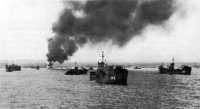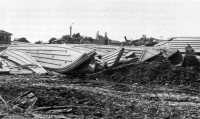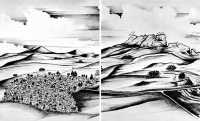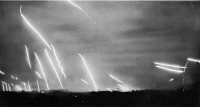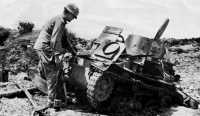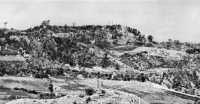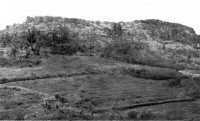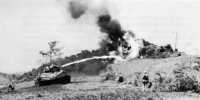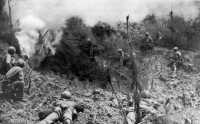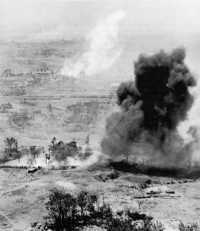Chapter 12: The Japanese Counteroffensive and its Aftermath
A hundred feet below Shuri Castle, in a small chamber shored up with heavy beams, the top commanders of the Japanese 32nd Army met on the night of 2 May to make a fateful decision. General Ushijima’s staff was still divided over strategy. General Cho, the chief of staff, continued to press for an immediate large-scale attack. The time was ripe, he said, for a decisive blow. Colonel Yahara, clinging to his faith in defensive tactics, opposed the attack as premature.
Sake was flowing freely, and the meeting became tense and quarrelsome. When it was proposed that the 63rd Brigade of the 62nd Division come under command of the 24th Division for an attack, the brigade commander, General Nakashima, retorted hotly with a pointed and biting comparison of the abilities of the 62nd and 24th Divisions. His brigade would not fight as a mere branch of a weak tree; rather it would die where it stood. General Nakashima won his point, and the meeting moved quickly to a decision. General Fujioka, commander of the 62nd Division, vehemently backed up Cho. Most of the Japanese commanders were impatient with defensive fighting and saw no prospect of success in a battle of attrition. Colonel Yahara’s warnings were unavailing, and once again he was overruled. General Ushijima ordered an all-out offensive by 32nd Army for 4 May.1
Planning the Offensive
Plan for Combined Operations
Even before the Japanese commanders conferred at Shuri headquarters, their operations officers had been framing attack orders and telephoning the gist of them to unit commanders. The final plan was ambitious. The enemy aspired to destroy the XXIV Corps on Okinawa and to disable the Allied fleet offshore in a series of heavy, coordinated blows. To this end he committed a sizeable portion of his ground, air, and amphibious forces.
The 24th Division was to make the main effort in the ground attack. This unit, comprising approximately 15,000 men under the command of General Amamiya, was largely intact on 3 May except for its 22nd Regiment, which had seen extended action. Amamiya’s mission was to drive strong spearheads through the center and left (east) of the American lines. Once the XXIV Corps front was disrupted, his remaining forces, supported by other Japanese units pouring through the gaps, would systematically destroy the Corps in a series of day and night attacks.
The amphibious attack was to come in the form of landings from barges over the beaches behind the American front lines. Several hundred men of the 26th Shipping Engineer Regiment, loaded with light arms and satchel charges, were ordered to land on the west and destroy American tanks and artillery. The aid Engineers had a similar mission on the east coast. The raiders were formally detached from their units and ordered not to return.2
The Japanese offensive was to coincide with a major attack by Kamikaze planes and suicide boats against the American ships off Okinawa. The enemy was convinced that a successful assault against American supply lines would be a decisive blow in the campaign. The unending stream of supplies and ships was demoralizing to him. “There were so many they looked like an island,” a member of the 24th Division wrote plaintively on the eve of the attack after he viewed the American ships. “I wish we could somehow get air superiority back.”3
Plan for the Ground Attack
The Japanese planned their ground attack with extreme care. This was to be no banzai charge. The enemy’s intelligence had formed an accurate estimate of American dispositions, and his orders were clear and explicit. Divisions, regiments, battalions, and companies were given definite objectives and precise boundaries. Units in close support followed designated routes. Commanders were ordered to dispatch infiltrating squads to gain up-to-date information. The efforts of supporting arms, such as artillery, tanks, and engineers, were thoroughly integrated with the infantry action.4
The 24th Division, occupying the eastern half of the front, was to open the attack at daybreak of “X Day,” 4 May. “After effecting a quick rupture of the enemy front lines,” General Amamiya’s order read, “the division will continue penetration and annihilate him at all points by continuous night and day attacks.” By sunset of the first day the Japanese were to have penetrated two miles into the opposing lines to a point northeast of Tanabaru. The final objective was an east-west line at Futema, site of the 96th Division command post, which the Japanese mistakenly thought to be General Buckner’s headquarters.
The attack was to be two-pronged. Following a 30-minute artillery preparation at daybreak, the 89th Regiment on the east was to break through in the Onaga area. The 32nd Regiment, also supported by artillery, was to penetrate American lines in the Maeda area. Tanks were to support both prongs. Raiding and infiltration units were ordered to follow in the wake of the “break-through troops.” Once the 24th Division was established at the first objective northeast of Tanabaru, the Japanese troops were to dig in against American counterattacks, set up antitank traps, and prepare to continue the attack northward.
The 22nd Regiment and the 44th Independent Mixed Brigade had special missions. Located in the center of the 24th Division’s line, the 22nd Regiment was to screen the advance of the other two regiments with smoke and fire. Then, echeloned to the left rear of the 89th Regiment, the 22nd would join in the attack. The 44th Independent Mixed Brigade, a fresh unit, was ordered to protect the Japanese left flank during the attack. Following the expected break-through east of Maeda, the 44th was to turn left toward Oyama on the west coast and thus cut off the 1st Marine Division. The enemy high command evidently considered the breakthrough at Maeda to be the critical blow, for his troops were especially well supported by tanks, artillery, and antitank elements. (See Map 37.)
Rear Echelon Support
The Japanese reasoned that success depended on the extent to which they could support their frontline troops with artillery, tanks, supplies, and communications. Their plans specified in detail the role that each of the support units was to play in the projected operations.
Artillery units were ordered to regroup in preparation for the attack. Guns and howitzers were pulled out of cave positions and set up farther south in more open emplacements for greater flexibility. They were to open fire thirty minutes before the attack. When the infantry had driven through the American
front lines, artillerymen were to move their weapons forward. The 27th Tank Regiment, hitherto uncommitted, was ordered to move from its position near Yonabaru during the night over several routes and support the attack in the Maeda area.
Japanese signalmen had the task of putting in a trunk line between the Shuri headquarters and a point behind the front. As the troops moved forward, the line was to follow. Before dawn on the 4th, a signal net was to connect “break-through units” with artillery and transport elements. First-aid sections, two of which were assigned to each of the spearheads, would collect the wounded in caves and send the worst cases to the rear on trucks and carts. Engineers were responsible for road maintenance and for “mopping up” behind the assault troops.
Ammunition and other supplies were carefully allotted. The infantry was allowed rations for ten days. Trucks were to follow the troops closely, working out of designated supply points. General Amamiya ordered that “critical materials will be supplied with caution when required, and captured stores will be used to best advantage. The division’s fighting strength will be constantly maintained and cultivated.”5
The offensive was to open at dawn of 4 May. “Display a combined strength,” final orders read. “Each soldier will kill at least one American devil.”6
The Offensive Under Way
All these preparations the Japanese concealed with remarkable skill. On 2 May Col. Cecil W. Nist, XXIV Corps intelligence officer, noted a definite decrease in the volume and intensity of enemy artillery fire, and sound-plots located Japanese pieces nine miles south of their front lines. Colonel Nist conjectured that the enemy was withdrawing his guns farther south – a move which could foreshadow a general Japanese withdrawal. No one divined the enemy’s real intent. General Buckner believed that the enemy’s rigid type of defense made it impossible for him to launch more than minor counterattacks.7
Japanese rear areas, quiescent during the daylight hours when there was constant air observation, burst into activity soon after sundown on 3 May. Artillery opened up with heavy concentrations on American front lines. Enemy
troops moved up to their appointed positions. Small units of three or four men, variously designated as “reconnaissance raiding” and “rear harassing” teams, proceeded toward the American lines to attack command posts, heavy weapons, communications, and depots and to send back information by means of smoke signals. The 27th Tank Regiment rumbled up to Ishimmi, several of its tanks being severely damaged by American artillery fire en route.8 On beaches south of Naha and Yonabaru, men of the shipping engineer regiments piled into barges and assault boats.
“The time of the attack has finally come,” a Japanese infantryman wrote in his diary during the evening. “I have my doubts as to whether this all-out offensive will succeed, but I will fight fiercely with the thought in mind that this war for the Empire will last 100 years.”9
Sorties in the Night
The Kamikazes struck at American shipping at dusk on 3 May. Five suicide planes crashed into the Aaron Ward inside of one hour, firing the ship and killing or wounding ninety-eight men. Three others carrying bombs sank the Little. Two vessels were sunk and four damaged, but American planes and antiaircraft fire accounted for fourteen suicide planes and twenty-two other enemy aircraft before dark. The Japanese also bombed shore installations, concentrating on Yontan airfield.10
Armed with antitank guns, heavy machine guns, light arms, and thousands of satchel charges, several hundred men of the 26th Shipping Engineer Regiment headed under overcast skies for landing places below Yontan and Kadena airfields. They miscalculated their position and turned, into the shore at a point where it was heavily defended. At 0200 riflemen of the 1st Marine Division on the sea wall near Kuwan caught sight of ten barges and opened up with concentrated fire. Naval flares lighted up the area. One company fired 1,100 rounds from 60-mm. mortars. Several enemy barges burst into flames. One platoon of marines used fifty boxes of ammunition and burned out six machine-gun barrels as it sprayed the Japanese trying to cross the reef. (See Map 38.)
Many of the enemy managed to reach the shore; some of these fled back to the Japanese lines and others were cornered in Kuwan, where the marines mopped them up at leisure. All the landing boats were destroyed. A smaller group of Japanese advanced almost as far as Chatan, landing one and one-half
Japanese air and sea attack on transports left supply craft beached and still burning the morning of 4 May. Scene is near mouth of the Bishi River
Some 48-foot folding landing craft, a type used by the Japanese in their attempted surprise landing during the night of 3-4 May, were found at Naha after its capture
miles south of there at Isa, but they were contained without major difficulty and during the following day were destroyed.11
The shipping engineers were even less successful on the east coast of Okinawa. After a trip northward in various types of boats, including native-type boats rowed by Boeitai, several hundred tried to land behind the 7th Division lines, but most of them were killed by fire from ships in Buckner Bay or by the 7th Division Reconnaissance Troop and 776th Amphibious Tank Battalion on land.12
The amphibious attack was a complete fiasco. The enemy lost from 500 to 800 men and almost all their landing craft. The engineer regiments never mounted another amphibious attack of any proportion; the survivors fought as infantry in the final operations on Okinawa.
The 24th Division Attacks
Never had the 7th Infantry Division in its long combat in the Pacific experienced such shelling as swept its front lines during the night of 3-4 May. The enemy, using all types of weapons down to 20-mm., fired more than 5,000 rounds on the division during the night. To reach the Americans in their foxholes, he used airburst artillery and 70-mm. barrage mortar shells which burst in the air and in turn scattered more explosives to blow up on the ground. With their field pieces now in the open enjoying wide fields of fire, the Japanese artillerymen were gambling that the infantry attack would overwhelm XXIV Corps artillery before it could search out and destroy their weapons.13
In the pitch darkness Japanese troops made their way toward the American front lines. At 0500 two red flares ordered them to attack. As the artillery fire became heavy, a guard of Company A, 17th Infantry, on a hill just north of Onaga, dropped back below the crest for cover. He thought that the enemy would not attack through his own artillery, but the enemy did just that. A few Japanese appeared on the crest and set up a light machine gun. Pfc. Tillman H. Black, a BAR man, killed the gunner, and as more of the enemy came over the crest he killed four Japanese who tried to man the machine gun. The enemy advanced over the crest in ragged groups, enabling Black to hold his own. Soon the whole company was in action and drove the enemy off the
crest. The Japanese abandoned three light machine guns, four mortars, and much ammunition.14
At another point a surprise attack nearly succeeded. On high ground 1,000 yards east of Onaga a group of Japanese crept up the hill in front of Company I, 184th, commanded by Capt. James Parker. In the sudden onslaught that followed, two heavy machine gun crews abandoned their positions. One of them left its weapon intact, and the Japanese promptly took it over and swung it around on the company. Parker, watching the attack from the ridge, had anticipated the move. The Japanese managed to fire one burst; then Parker destroyed the usurped weapon with his remaining heavy machine gun. For an hour or two longer the Japanese clung to the forward slopes, firing their rifles amid shrill screams, but they made no further progress.
By dawn the general pattern of the Japanese attack on the left (east) of the XXIV Corps line was becoming clear. In the 184th’s sector the enemy’s 89th Regiment, following instructions to “close in on the enemy by taking advantage of cover,”15 had advanced around the east slopes of Conical Hill, crept across the flats, and assembled in force around the “Y ridges” east of Onaga. They had outflanked three companies of the 184th on Chimney Crag and the Roulette Wheel north of Kuhazu, and had also managed to evade the forward battalions of the 17th around Kochi. Another Japanese element had attacked 7th Division lines on the high ground north of Unaha.
At dawn 1st Lt. Richard S. McCracken, commanding Company A, 184th, observed 2,000 Japanese soldiers in the open area east and north of Kuhazu. They were perfect “artillery meat.” Unable to get through to his artillery support, McCracken called his battalion commander, Colonel Maybury, and described the lucrative targets. Maybury was equally pleased. McCracken suggested, however, that the Colonel should not be too happy – a group of Japanese at that moment was within 100 yards of Maybury’s observation post.
“Oh no,” Maybury said, “that’s a patrol from Company K down there.”
“I don’t know who the hell it is,” McCracken said, “but there’s a lot of them and they’ve got two field pieces that are pointed right at your OP.”
There was indeed a party of Japanese busily unlimbering two 75-mm, howitzers just below Maybury. But Company C, 17th Infantry, had spotted this activity, and within a few minutes maneuvered tanks into position and scattered
the enemy group. Artillery eliminated the Japanese caught in the open.
The 3rd Battalion, 184th, beat off an attack by 200 Japanese, who thereupon withdrew to the ruins of Unaha and set up mortars. A mortar duel ensued, sometimes at ranges of 250 yards. The 3rd Battalion, 32nd, also poured fire on the enemy there. After the impetus of the attack was lost, a Japanese officer stood out on open ground and waved his saber to assemble his men for an attack. American mortarmen waited for a worth-while target to develop, then put mortar fire on it. Four times the officer assembled a group, only to have his men killed or scattered, before he was finally killed.
By 0800 the Japanese had been driven beyond grenade range on the entire 7th Division front. But they did not abandon their attack, perhaps because they had been ordered to advance “even until the last man.”16 They made the mistake of milling about in the exposed flatland, where they became perfect targets; they neither pressed the attack nor essayed an organized withdrawal. American heavy weapons fenced off avenues of retreat in order to contain the enemy in open areas. “We laid them down like ducks,” a platoon sergeant reported.
Tank-Infantry Attack in the Center
While the 7th Division was repelling the Japanese attack in the eastern sector of the XXIV Corps line, the 77th Division was blunting the other enemy “spearhead” in the center. Here the Japanese 32nd Regiment, supported by tanks and engineers, attacked behind intense artillery fire. This sector was the critical point of attack, for a break-through here would enable the supporting 44th Independent Mixed Brigade to cut west and isolate the 1st Marine Division.
Transportation difficulties beset the 32nd Regiment almost from the start. During the night light tanks drove out of Shuri up the Ginowan road (Route 5), but American artillery interdicting the road prevented medium tanks from following. The mediums had to take a long detour, which was in such poor condition that only two of the tanks could enter into the attack. Trucks and artillery also were slowed down. Even foot troops had trouble in moving. One Japanese infantryman recorded that his column was shelled on the way and that everyone except himself and one other was wounded. Another wrote of encountering “terrific bombardment” on the way to Kochi. These difficulties severely handicapped the 32nd Regiment in ensuing operations.17
Position occupied by the Japanese in their penetration to Tanabaru escarpment, 4-7 May
Image merged onto previous page
Japanese land offensive of 4-5 May was opened by rocket barrages. The erratic paths of enemy fire shown above are in sharp contrast with those of more accurate American weapons
A knocked-out Japanese light tank is examined by a 96th Division soldier. All enemy tanks used in the predawn offensive 4 May were destroyed
Supported by nine light tanks, the 3rd Battalion led the assault of the 32nd Regiment against the 306th Infantry, 77th Division, before dawn on 4 May. The enemy mounted his assault from southeast of Hill 187 and hit the 77th where Route 5 curled around the east end of Urasoe-Mura Escarpment. The Japanese drove into the front lines of the 1st Battalion, 306th, near Maeda. Although the enemy found the weak points of the line, American automatic fire split up the attacking forces. As in the case of their right “spearhead,” the Japanese were unable to move into the American lines at any place with sufficient force to break through. The enemy’s only success consisted of driving a platoon off one of the hills. American artillery was called in against the Japanese tanks. Several were knocked out, and, as the infantry stalled, the rest withdrew.18
Shortly before daylight, when the Japanese infantry had failed to take its initial objectives east of Hill 187, Colonel Murakami, commanding the 27th Tank Regiment, became impatient and recklessly committed his own infantry company, a standard element of a Japanese tank regiment. American artillery fire destroyed one platoon, disrupting the attack, and daylight found the surviving troops in a precarious position across from the American lines. Colonel Murakami ordered the company to withdraw, but artillery fire prevented a retreat during the day. When the Japanese used smoke for concealment, the Americans simply blanketed the obscured area with shell fire. The survivors straggled back to their front lines after nightfall. All the light tanks that had supported the attack were lost.19
By 0730 the 306th Infantry had driven off the enemy. Broken up into small groups, the Japanese tried to pull back over ground swept by tremendous volumes of artillery and mortar fire, but few got through. Continued attack was impossible. At 0800 the commander of the Japanese 3rd Battalion radioed the 32nd Regiment command post at Dakeshi: “Although the front lines on the high ground southeast of Maeda advanced to the line of the central sector and are holding, further advance is very difficult due to enemy fire. There is no tank cooperation.”20
Artillery and Air Attack
On 4 May, for the first time in the campaign, whole batteries of enemy artillery were visible. By bringing his field pieces out into the open the enemy was
able to deliver more than 13,000 rounds onto American lines in support of the attack. He ringed his artillery with antiaircraft guns, chiefly 75-mm., to keep off cub planes, and he used smoke pots to hide the flashes of the firing. This gamble proved to be a costly failure. By taking advantage of area artillery barrages which drove Japanese antiaircraft crews to cover, American cub planes were able to pinpoint many Japanese artillery positions for precision fire. During 4 May American counterbattery destroyed nineteen enemy artillery pieces and during the next two days forty more. The Japanese thereupon moved their remaining weapons back into caves. With the lessening of Japanese artillery fire, the number of combat fatigue cases among American troops dropped correspondingly.21
The Japanese effort in the air on 4 May was more successful. From dawn to 1000 American naval forces were under continuous attack by enemy planes using Kamikaze tactics, and many of the light units were sunk or damaged. Four planes crashed into the U.S. destroyer Morrison, and the ship sank in eight minutes, with 154 casualties. A Baka bomb hit and fired the Shea, killing twenty-five and flooding the forward compartments, but the ship stayed afloat. A plane over the transports in the Hagushi area, after receiving fire from many ships, dived straight down into the Birmingham just aft of Number 2 turret. The impact carried the motor of the plane through three decks, and the 250-pound bomb burst in the sick bay. There were ninety casualties. More Japanese planes attacked at dusk. A suicide flyer hit the escort carrier Sangamon, destroying twenty-one planes on the flight deck. Her entire hangar deck was gutted by fire, and all radar and bridge control was knocked out. From the evening of 3 May until that of 4 May the Japanese had sunk or damaged 17 American ships and inflicted 682 naval casualties, while American planes and naval gunfire had destroyed 131 enemy planes. The enemy’s air attack, which was simply one phase of his unceasing air campaign against the invading forces, amounted to 560 raids by 2,228 enemy planes between 1 April and 17 May and was probably the most profitable effort of his entire counteroffensive.22
Japanese Penetration to Tanabaru, 5 May
General Amamiya refused to abandon the attack. Although both “spearheads” of his 24th Division had smashed vainly against the American defenses,
suffering heavy losses in the process, he ordered another assault for the night of 4-5 May. The 1st Battalion, 32nd Regiment, and the attached 26th Independent Infantry Battalion were directed to penetrate XXIV Corps lines northwest of Kochi in a night attack. The 1st Battalion had been used in support of the Japanese left “spearhead” on the 4th, but it had not been fully committed and was still relatively intact.
The reason for Amamiya’s persistence after the morning’s debacle is not clear, but one event of the day may well have led to his decision. Unknown to XXIV Corps, elements of the 1st Battalion, 22nd Regiment, had penetrated more than 1,000 yards behind the American lines near Kochi. After dusk on the 4th these elements were ordered to pull back to their regimental lines. Amamiya may have reasoned that he had found a weak point in the American defenses. In any event the 1st Battalion of the 32nd was given a similar route of approach, lying near the boundary between the 7th and 77th Divisions.23
Break-through at Night
The Japanese, having shelled the lines of the 306th Infantry during the night of 4-5 May, at 0200 launched an attack on the 306th where it straddled Route 5 northwest of Kochi. American artillery broke up this attempt. Three hours later the enemy attacked in battalion strength, supported by tanks. Although six tanks were soon knocked out, the Japanese pressed on through artillery and mortar fire to engage the 306th in close combat. They isolated a battalion observation post and killed or wounded its five occupants. Despite hostile heavy mortar fire, the Japanese set up knee mortars and heavy machine guns close to the American lines and even tried – unsuccessfully – to emplace a 75-mm. gun.24
Fierce fire fights developed along the regiment’s entire line. One enemy force, moving up a draw in close column formation, marched squarely into a company and was destroyed by automatic weapons fire. Most of the Japanese, unable to close in for hand-to-hand fighting, took refuge in ditches just in front of the American positions. Grenade duels and exchanges of automatic fire continued until midday. By dawn, however, the 306th had the situation in hand. American tanks moved along the ditches and machine-gunned the enemy. Some of the surviving Japanese, using smoke for concealment, managed to withdraw to their lines. They left 248 dead in the 77th Division’s sector,
Tanabaru Escarpment viewed from position of the 17th Infantry, 7th Division, on a finger of Hill 178. Company E, 17th, moved back to the secondary crest (right) on morning of 6 May after enemy had counterattack in force
The north and west sides of the Tanabaru escarpment, where Company F, 17th, regained the hill 7 May
together with numerous machine guns, mortars, rifles, and several hundred rounds of 75-mm. ammunition for the gun they had failed to get into action.
Behind this noisy fire fight along Route 5, a large portion of the Japanese 1st Battalion, 32nd Regiment, managed to infiltrate through the XXIV Corps line. The Japanese made their penetration at a point between Route 5 and Kochi. This route lay within the 77th Division sector but close to the divisional boundary between the 7th and 77th. About ninety of the infiltrating Japanese made their way into the command post of the 306th Infantry, but they did little damage and were killed during the following day. Most of the Japanese, numbering approximately 450, crossed the divisional boundary and reoccupied the town of Tanabaru and Tanabaru Ridge. The deepest penetration was more than a mile behind the Corps front.25
The town and ridge had constituted a strong point on the first Shuri defense line, dominating much of the adjacent area. This position had never actually been taken by American troops; the Japanese had abandoned it on the night of 23 April when the rest of the line cracked. The escarpment dropped abruptly in a steep coral cliff on the north. The town stretched along the southeast slope of the ridge and was divided by a road running south to Onaga and Kochi. The front-line battalions of the 17th Infantry, 7th Division, were supplied over this road. While the Japanese held at Tanabaru, this supply road was effectively cut.
Battle Behind the Lines
Through field glasses sentries of the 17th Infantry could see in the moonlight a column of troops moving northwest against the skyline on Tanabaru Escarpment The 17th fired on some of the troops but was handicapped by fear of endangering friendly troops. Other Japanese columns apparently passed undetected. The enemy quickly located and cut the telephone wires between regimental headquarters and the three battalions, but the regiment was able to record enemy movements through its units in the rear areas. The Japanese also surrounded and attacked supply dumps at the base of the ridge and were barely prevented from destroying them.26
The job of cleaning out the infiltrating Japanese fell to Company E, which sent a patrol of platoon strength up the east slope of the escarpment. When the Japanese on the heights held up this patrol with fire, 1st Lt. Walter J. Sinkiewicz,
commanding Company E, committed the rest of his unit. One platoon almost reached the top, but the enemy drove it back with mortar, machine-gun, and light-arms fire, killing two and wounding seven. A sharp fire fight developed, during which Sinkiewicz and his three platoon leaders were all wounded.
The Japanese were meanwhile making the most of their position. Their fire covered the 1st Battalion’s supply dump and motor pool on the north side of the ridge, rendering them inaccessible to the Americans. Enemy groups in Tanabaru mined the supply road through the town and blanketed the road with machine-gun fire. A half-track carrying medical supplies was disabled by a mine, and a medical officer was killed as he tried to escape. The Japanese occupied the vehicle and converted it into a pillbox. An American patrol killed eleven Japanese in and around the vehicle. S/Sgt. Carl W. Johnson volunteered to retrieve the weapons in the half-track; he made three successful trips across exposed ground but was killed on the fourth.
By noon of 5 May there was apprehension at the regimental command post, which had not fully appreciated the strength of the infiltration. From a hill near the command post Lt. Col. Albert V. Hard, executive of the 17th Infantry, could plainly see several Japanese soldiers 600 yards away on Tanabaru Escarpment. The Japanese were in turn watching American activity. Lying on his stomach, Colonel Hard fired some shots from an M1 at the Japanese to “neutralize” them. While he was so engaged, a soldier ran up with a radio report that the German armies had surrendered. “Well now,” Hard said, “if we just had the Japs off the escarpment we’d be all right, wouldn’t we?”
With Company E stalled on the east slope of the escarpment, Company F attempted a broad flanking attack. Two of its platoons on the line, supported by tanks, pushed through Tanabaru and knocked out hastily established defenses. Beyond the town the company drew heavy fire from numerous caves, and it spent the rest of the day destroying the Japanese in these positions. Company E thereupon took over the burden of the attack, and by 1730 it had reached the top of Tanabaru Escarpment behind a mortar preparation. This move enabled the 1st Battalion to transfer its vehicles and supplies to a safer location, but the supply route was still blocked.
Early in the morning of 6 May a force of Japanese just below Company E pressed in on the Americans with grenades and satchel charges. After suffering sixteen casualties in half an hour, Company E retreated off the top to a protected ledge just below. Here the survivors formed a line and bombarded the top of the hill with grenades to deny it to the enemy. While some members of
the company hauled new boxes of grenades up the steep trail, the others lobbed several hundred grenades on the Japanese, who withdrew from the exposed top at dawn.
Company F returned to Tanabaru the same morning for a second sweep through the town and killed eight Japanese. Supported by mortar fire and aided by small-arms fire from Company E, Company F initially made rapid progress on the slope but then ran into a series of coral outcroppings. With portable flame throwers, mortar fire, and quantities of grenades, the troops eliminated all resistance on the slope by evening.
On the following day, Company F attacked the crest of Tanabaru Escarpment from the west behind mortar fire and quickly gained the top. Trenches were littered with Japanese dead, most of them killed by 81-mm. mortar fire. The amount of Japanese and American equipment found on the escarpment explained the ability of the enemy to hold out so tenaciously. Enemy equipment included one 75-mm. pack howitzer with ammunition, 2 heavy machine guns, 6 light machine guns, 2 knee mortars, 3 magnetic mines, and a large quantity of ammunition. Their American weapons consisted of 2 light machine gun, 2 BAR’s, 3 carbines, and 3 Tommy guns. A total of 462 Japanese were killed in the area of Tanabaru during the 3-day battle, most of them on the escarpment and others as they tried to make their way back to their lines.27
Failure of the Offensive
By midnight of 5 May it was clear to General Ushijima that the offensive had failed. He had suffered tremendous casualties and had made no headway except in the Tanabaru area. Even there his troops were being compressed. General Ushijima realized that he must revert to defensive warfare. “The Army will temporarily halt its offensive,” he ordered, “because of the opportunity offered by the painful blows against the enemy. ... The battle plan in the Shuri area sector will be an attrition of enemy strength until he has lost his endurance. The 24th Division... will shift to a holding basis.”28
Despite Ushijima’s bravado, 32nd Army Headquarters was sunk in gloom over the failure of the offensive. During the day Ushijima called Colonel Yahara to his office and declared with tears in his eyes that henceforth he would be guided by Yahara’s opinions. Yahara felt that the battle had been the decisive event of the campaign. Even General Cho, who was considered by many officers to be the incarnation of the fighting will of the Japanese Army, gave up hope
for victory and said that defeat was only a matter of time. This pessimism was reflected down the line. One Japanese lieutenant wrote in his diary, “We realized that we were doomed when we heard of the failure of the 24th Division.”29
The Japanese lost in the attack approximately 5,000 troops, including those killed in the counter-landings. The 24th Division was greatly reduced in strength. On 5 May the combat strength of its 32nd Regiment was down to 30 percent; two battalions of the 32nd were at 15 percent. The 27th Tank Regiment never fought as a mobile unit again; its six remaining medium tanks were converted to stationary artillery and pillboxes northwest of Shuri. Japanese artillery and shipping engineers also went into decline. The 44th Independent Mixed Brigade was still intact, however, for it had not been committed after it became apparent that the 24th Division would be unable to break through.30
American casualties during the enemy offensive were heavy. On 4z? May 335 were killed or wounded, excluding 352 casualties of the 1st Marine Division, which was not involved in the enemy ground attack. On 5 May the two divisions hit hardest by the counterattack and penetration, the 7th and 77th, suffered 379 casualties. These losses are comparable to those previously incurred during the heaviest fighting in the Kakazu Ridge struggles and in the first few days of the general attack starting 19 April.31
Notwithstanding their heavy losses during the Japanese offensive, the Americans, in general, suffered less from Cho’s aggressive tactics than from Yahara’s defensive methods. The 1st Marine Division, for example, which was barely touched by the Japanese offensive on 4 May, had more casualties on that date than the two other divisions of the Corps combined; most of the losses had been suffered in making an attack west of Machinato airfield against strong enemy defenses. Colonel Yahara had hoped to exact such losses for every small advance by the Americans across the entire line week after week. The Japanese counter-offensive of 4-5 May showed the superiority of Yahara’s tactics to Cho’s. Over-ambitiously conceived and ineptly executed, the offensive was a colossal blunder.
The Americans Resume the Offensive
The XXIV Corps now resumed its attack, which in several sectors of the front had hardly been interrupted by the Japanese offensive. Because the Japanese
had used almost all their fresh reserves in the counterattack, General Buckner could feel confident of the launching sometime in May of a general attack on the Shuri defenses. On 7 May General Hodge ordered that preparatory to this coordinated Tenth Army attack the advance was to continue to the Asa–Dakeshi–Gaja line, to be seized by the evening of 8 May. Upon reaching this line, “a bare minimum,” the attack was to continue in order to gain as much ground as possible for later offensive action.32
After the failure of their offensive, the Japanese turned all their energies toward waging a prolonged battle of attrition. Their losses did not impair immediately their defensive capacities; thus the XXIV Corps found no weak point in the Shuri defenses resulting from the ill-starred offensive. By throwing fresh troops into the attack of 4 May Ushijima had been able to maintain his strength all along the line. Nor was there any breakdown in his command and staff operation. Front-line units were reorganized without seeming loss of effectiveness; available reinforcements were carefully allotted to existing regiments; local counterattacks were timed for maximum effect.33
General Ushijima’s chief task now was to keep sufficient combat troops at the front to man his Shuri defenses. It was apparent by 7 May that the strength of the remaining regular infantry was not great enough for this task. Consequently, Ushijima converted service units into infantry combat groups. By mixing service troops with the “regulars,” he exacted from them their maximum combat effectiveness. “One man in ten will continue with his rear-echelon duties. The remaining nine men will devote themselves to antitank combat training,” one order stated.34
The reorganization of the 32nd Regiment, 24th Division, was typical of the resourcefulness of the Japanese. The regimental headquarters received 5 men from the 24th Transport Regiment. The 1st Battalion kept its own surviving members and was allotted all the survivors of the 2nd Battalion, 20 men from the 7th Shipping Depot, 90 from the 24th Transport Regiment, and 9 from the 26th Sea Raiding Squadron. The 2nd Battalion was totally reconstituted from the 29th Independent Infantry Battalion and other units. The 3rd Battalion was reorganized in a manner similar to that used with the 1st. It was by this process of piecing units together that the 32nd Army was able to stay intact long after the original
combat units had been virtually destroyed – a capability which at the time American intelligence officers found “baffling.”35
After his offensive failed, the enemy formed a line in which the relative position of the major units was to remain roughly the same until the end of the battle. On the east the 24th Division, reinforced by two independent battalions, held the line as far as Shuri, with its 89th Regiment on the east, its 22nd in the center, and its 32nd on the west. The remnants of the battered 62nd Division were stretched from a point north of Shuri almost to the west coast, holding about one-third of the line. Along the Asa River estuary was a battalion of the 44th Independent Mixed Brigade.36
The Japanese husbanded their remaining heavy weapons, especially their artillery, as carefully as they meted out their manpower. On 6 May the Japanese 5th Artillery Command directed its units to “revert to the [defensive] situation which held prior to the attack situation of 3 May.” Once again the protection of individual pieces was a cardinal feature of enemy operations. Artillery units were ordered to “use ammunition with the utmost economy” and to “wait and fire for effect against vital targets.”37
Marines Fight for Hill 60
Turning east to seize the high ground that dominated the Asa River estuary, the 1st Marines on 6 May drove toward Hill 60, a small hump one-half mile southeast of Yafusu. (See Map 39.) The mission was an extremely difficult one. Hill 60 was commanded by Japanese fire from Dakeshi Plateau and Ridge, Wana Ridge, and high ground south of the Asa River. Moreover, Nan Hill, a hillock 200 yards north of Hill 60 from which the attack was to be supported, was not yet wholly in Marine hands. In a classic demonstration of reverse-slope tactics, the Japanese had relinquished the crest and northern slope of Nan to the Americans but still held numerous caves on the southern slope as well as tunnels underground. Men of the 2nd Battalion, 1st Marines, had to ward off incessant forays on Nan during the night; some of them were bayoneted or knifed to death in their foxholes.38
The 2nd Battalion attacked Hill 60 at 1000 on 6 May, supported by mortar, artillery, and naval fire. The Japanese dug in on the reverse slope of Nan
Attacks on Hill 60 by marines developed into a tank, flame, and demolitions battle. A tank infantry team attacks northwest slope of hill 60
Marines await result of a blasting charge, prepared to pick off any Japanese who might attempt escape
opened up on the attackers from their flank and rear. The Marine platoons quickly lost contact with one another and left a trail of casualties in their wake. Tanks met Japanese mortar and 47-mm. fire as soon as they moved onto open ground; two were destroyed and left burning and another disabled, after receiving a total of ten hits. One platoon reached the crest of Hill 60, only to come under a holocaust of grenades, satchel charges, white phosphorus shells, and knee mortar shells. Marines on Nan Hill were unable to move off to support the attack because of the Japanese just below them. At 1227, after the marines on Hill 60 had suffered thirty-five casualties without consolidating their position, the 2nd Battalion commander ordered them to withdraw.
Next day a second attack on Hill 60 by the 2nd Battalion was equally unsuccessful. Although four battalions of artillery, a fire support ship, and 81-mm. and 60-mm. mortars put concentrated fire on the slopes and crest of Hill 60, the marines who gained the top again came under concentrated enemy fire. The fighting was at such close range that it was impossible to keep enough grenades on the line, and the marines used rifle butts against Japanese who tried to storm their position. One wounded sergeant directed his squad until the moment he died. The troops lost their hold at one point, then fought their way to the top again. But the continuing Japanese fire from the reverse slope of Nan Hill was the decisive factor, and at 1700 the marines pulled back after losing eight killed and thirty-seven wounded.
The 2nd Battalion now redoubled its efforts to destroy enemy positions on Nan Hill. The marines found the task hazardous and often disheartening. Demolition charges placed in one cave sometimes blew out several other openings as well. Rushing for defilade during blasting, a marine might find himself in another part of a tunnel. In several instances caves were unsealed by Japanese digging out from the inside. But the work went steadily on. With relays of tanks and flame-thrower tanks, demolitions, and hundreds of gallons of napalm, the marines cleaned out Nan Hill by 9 May.
With Nan completely “processed,” marines attacked Hill 60 again on 9 May. While the 1st Battalion assaulted the northwest portion of Dakeshi Plateau, the 2nd Battalion moved on Hill 60. Careful coordination of tanks, infantry, and supporting weapons brought quick results, and by the end of the day Hill 60 was securely in Marine hands.
XXIV Corps Advances on the Left
After extensive patrolling during 5-6 May, the 184th Infantry, 7th Division, resumed its southward drive. The initial objective of Colonel Green, commanding
officer, was Gaja Ridge, which had been won and lost on a May. On 7 May this ridge was occupied with astonishing ease. A platoon-sized patrol having operated freely along the tip of Gaja Ridge, infantrymen of the 3rd Battalion started across the flats southwest of Unaha in deployed formation and were in place along the length of the ridge an hour later. The Japanese, who may well have been surprised by the speed of the attack, brought in a few artillery rounds but no small-arms fire.39
Further moves by the 184th into the western approaches of Conical Hill were more difficult. One patrol, cut off by machine-gun fire and shelled by mortars, had to fight its way back. A drive into Kibara stalled at the very edge of the town in the face of artillery and mortar fire. Mines in Kuhazu and Onaga prevented tanks from coming up in support. Infantry attacks on hills at the western terminus of the flatlands were more successful. William Hill fell on 7 May; the forward slope of Easy Hill, on the 8th.
During this period the chief obstacle to the 7th Division’s advance was a network of Japanese positions around Kochi Ridge and Zebra Hill just south of the town of Kochi. Previous attacks had demonstrated that the defenses here could not be overrun in a single attack but required a tedious, methodical destruction of individual enemy soldiers and positions. Any large-scale attack by the 17th Infantry, even though coordinated among battalions, was doomed to fail because of the combined fire power of enemy positions stretching from Shuri to Conical Hill – a volume of fire greater than a regiment could control.
The struggle for the Kochi positions, which had started on 26 April, was resumed after the Japanese counteroffensive failed. By 6 May the 3rd Battalion, 17th Regiment, was fighting for Knob 2 on Kochi Ridge and was trying to burn the Japanese out of the east side by rolling 10-gallon cans of napalm, gasoline, and motor oil over the top. On the same day two platoons of infantry seized a small portion of How Hill but, contrary to orders, retreated in the face of heavy fire from Kochi Ridge. At this point the 7th Division was under heavy pressure from XXIV Corps to push more aggressively. Accordingly, Brig. Gen. Joseph L. Ready, the assistant division commander, ordered Colonel Pachler’s 17th Infantry to attack Zebra Hill on the next day, 7 May.
Tanks and infantry of the 3rd Battalion moved out the next morning through Kochi. Their initial objective was an enemy strong point in the road cut between Zebra Hill and Kochi Ridge. This strong point formed the western
American advance down the center of the line, 77th Division sector, was slow and costly. Every knob of ground was fortified and fanatically defended. This photograph, taken from an artillery spotting plane 6 May, shows American tanks burning out a strong point on the edge of a village
anchor of the Japanese line running toward Kibara, from which the Japanese 22nd Regiment was ordered on 7 May “to exact as heavy a toll of the enemy as possible.”40 Heavy artillery fire held up the infantry, but the tanks plunged through Kochi to the west end of the road cut, and the troops followed as soon as the artillery slackened off. The strong point was a cave in the north side of the cut. Japanese fire from Knob 4 and neighboring heights, combined with the steep walls of the narrow passage, made this position almost inaccessible. Tanks poured flame and shells into the road cut, but when they prepared to return for resupply the enemy on Knob 4 opened up on the troops. After exchanging fire with the Japanese until midafternoon, the 3rd Battalion withdrew.
Meanwhile the 1st Battalion again seized How Hill and gained more ground on Kochi. Rain began on the afternoon of the 7th and continued into the next day, but the tired men of the 17th Infantry did not give up the attack. The platoon of 2nd Lt. William T. Coburn, who had joined Company G nine days before as a replacement, followed him to Knob 4 but was soon driven back by mortars and machine guns. Infuriated by the loss of two men killed and three wounded, Coburn and S/Sgt. George Hills returned to Knob 4 and hurled grenades at an enemy mortar crew in the road cut below. Although a mortar shell had severely wounded Hills, he and Coburn killed the Japanese in the cut.
By 9 May, when the 17th was relieved by the 382nd Infantry, 96th Division, the hold of the Americans on Kochi was almost complete. A straight and firm regimental line ran from How Hill to the crest of Kochi Ridge and thence to the southern end of Kochi town. However, the cave in the road cut, as well as all of Zebra Hill, was still in enemy hands. On 9 May the battalion of the Japanese 22nd Regiment which had held this area for three days was relieved by other units and commended by the regimental commander for “inflicting heavy casualties on the enemy.”41
Inching Along in the Center
In the very center of the island the 77th Division, after taking Maeda Escarpment, made step-by-step advances along Route 5 in its advance on Shuri. General Bruce used all weapons available, including air strikes, naval gunfire, and 8-inch howitzers, only to find the enemy still capable of putting up a fierce fight when the infantry and tanks moved up. The troops made use of seesaw tactics by which heavy weapons softened up a small area, permitting troops to
extend a salient from which they could support a similar effort in the adjoining sector. Nevertheless, progress was agonizingly slow.
The 5th Marines, 1st Marine Division, on the right (west) of the 77th, met equally stout resistance. The enemy positions to the immediate front of this regiment were organized around an area of rough ground known later as Awacha Pocket, northeast of Dakeshi and south of the town of Awacha. Here again the close teamwork of tanks and infantry, supported by heavy weapons, provided the only means of advance. Encircling this pocket required a week and was not finally accomplished until 11 May. By that time the marines had uncovered even more formidable positions to the south.
By 11 May XXIV Corps, though still far from the minimum line set by General Hodge, had eliminated many Japanese positions in preparation for the full-scale attack that was to follow. The week of 3-10 May had been one of general consolidation of the line that ran from Ouki on the east coast to Asa–Kawa on the west. At the expense of more than 20,000 casualties, including nonbattle,42 the American forces on the Shuri line had extended their line at Maeda, Kochi, and Awacha, thus making their lines of communication more secure and gaining more favorable terrain for the Tenth Army attack scheduled for 11 May.
